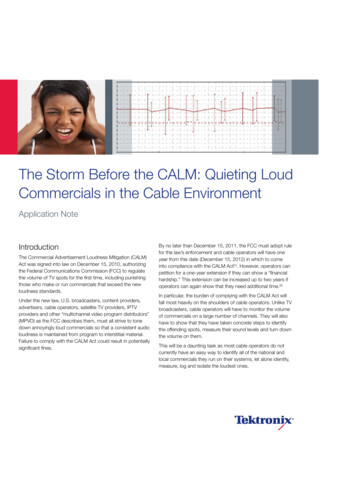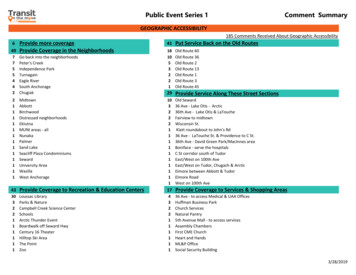
Transcription
The Storm Before the CALM: Quieting LoudCommercials in the Cable EnvironmentApplication NoteIntroductionThe Commercial Advertisement Loudness Mitigation (CALM)Act was signed into law on December 15, 2010, authorizingthe Federal Communications Commission (FCC) to regulatethe volume of TV spots for the first time, including punishingthose who make or run commercials that exceed the newloudness standards.Under the new law, U.S. broadcasters, content providers,advertisers, cable operators, satellite TV providers, IPTVproviders and other “multichannel video program distributors”(MPVD) as the FCC describes them, must all strive to tonedown annoyingly loud commercials so that a consistent audioloudness is maintained from program to interstitial material.Failure to comply with the CALM Act could result in potentiallysignificant fines.By no later than December 15, 2011, the FCC must adopt rulefor the law’s enforcement and cable operators will have oneyear from this date (December 15, 2012) in which to comeinto compliance with the CALM Act[1]. However, operators canpetition for a one-year extension if they can show a “financialhardship.” This extension can be increased up to two years ifoperators can again show that they need additional time.[2]In particular, the burden of complying with the CALM Act willfall most heavily on the shoulders of cable operators. Unlike TVbroadcasters, cable operators will have to monitor the volumeof commercials on a large number of channels. They will alsohave to show that they have taken concrete steps to identifythe offending spots, measure their sound levels and turn downthe volume on them.This will be a daunting task as most cable operators do notcurrently have an easy way to identify all of the national andlocal commercials they run on their systems, let alone identify,measure, log and isolate the loudest ones.
Application NoteCALM Act OverviewThe law mandates that the FCC adopt the AdvancedTelevision Systems Committee’s (ATSC) recent audio loudnessrecommendations for digital television, effectively turningthe standards-making engineering group into a quasiregulatory authority. Citing these standards, known as A/85Recommended Procedure (“ATSC A/85 RP”), the law thendirects the FCC to enforce the standards and establish theprocedures for assessing fines for violations.ATSC A/85 RP and ITU-R BS.1770:What They Are and How They WorkBoth ATSC A/85 RP and the ITU-R BS.1770 measurementalgorithm play central roles in the FCC’s enforcement of theCALM Act; therefore, it is vital that cable operators understandthem both and their roles in complying with the CALM Act.The FCC said it best in a recent public document stating,“Congress’ directive to us in the CALM Act is clear:incorporate by reference into our rules and make mandatorythe ATSC A/85 RP to prevent TV broadcast stations, cableand DBS operators, and other MVPDs from transmitting “loudcommercials” to consumers.”[3]ATSC A/85 RP was published in November 2009 to provideguidance to the TV industry – from content creators todistributors to consumers – about digital television audioloudness management. It was amended in May 2011 withthe addition of Annex J, which regards “the courses of actionnecessary to perform effective loudness control of digitaltelevision commercial advertising[4].” Specifically, it providesguidance to cable and DBS operators and other MVPDswhen they transmit digital programming content, includingcommercial advertisements, to consumers.More importantly, the ATSC A/85 RP has adopted theInternational Telecommunication Union RadiocommunicationSector (“ITU-R”) Recommendation BS.1770 measurementalgorithm as its loudness measurement standard and setsforth various techniques for MVPDs to control the loudness ofdigital programs.ITU-R BS.1770 provides a numerical value indicating theperceived loudness of the content. This numerical value isthen encoded into the audio content by the content provider,broadcast station or MVPD as a metadata parameter called“dialnorm.” The programming – along with the dialnorm – isthen delivered to the consumer and the AC-3 audio decoderin the consumer’s home receiver will automatically adjust thevolume based on the dialnorm value to eliminate spikes inloudness at these transitions.However, as straightforward as this approach appears,avoiding excessive loudness variations during contenttransitions on a channel (i.e., when an ad runs) or whenchanging channels, requires that the dialnorm valuecorrectly identifies the perceived loudness of the content itaccompanies. If the dialnorm value is incorrect, the AC-3audio decoder in the consumer’s home receiver won’t be ableadjust the volume to eliminate loud volume swings duringthese transitions.Recognizing this issue, the ATSC A/85 RP assumescompliance with the ATSC A/53 DTV Transmission Standard,which requires that the dialnorm value be accurately encodedand carried with the audio content. If all broadcast stationsand MVPDs measure content with the ITU-R BS.1770measurement algorithm and transmit dialnorm values thatcorrectly identify the loudness of the accompanying content,then consumers will not have to adjust the volume betweenprograms and commercials due to loudness variations.FCC online Encyclopedia FCC document FCC 11-84, page 19, section III, subsection C: “Financial Hardship and General Waivers”, paragraph 38[3]FCC document FCC 11-84, page 22, section IV: “Conclusion”, paragraph 45[4]FCC document FCC 11-84, page 4, section II: “Background”, paragraph 4[1][2]2www.tektronix.com/video
The Storm before the CALM: Quieting Loud Commercials in the Cable EnvironmentComplying with ATSC A/85 RPRequirementsEquipment Options for CALMComplianceATSC A/85 RP specifies two primary options for cableoperators to control loudness and comply with the CALM Act.Cable operators have not traditionally measured the audiolevels of their programs, rather they have just manuallymeasured the audio level of a single program for a shortperiod of time for other regulatory compliance purposes. Asa result, operators have mainly used audio measurementtools designed for the single-channel world of broadcasters,not the vast, much more complicated multi-channel cableenvironment.The first is to employ equipment, such as a loudnessmeasurement device and/or software, a file-based scalingdevice or a real-time loudness processing device.Section 2(c) of the CALM Act states that an operator willbe “deemed to be in compliance” with the FCC’s rules forimplementing the CALM Act if the operator “installs, utilizes,and maintains in a commercially reasonable manner theequipment and associated software” necessary to complywith the ATSC A/85 RP.The second option is to ensure that their content suppliersdeliver the content in accordance with the operators’ loudnessspecification (i.e., a fixed “target” loudness value or the correctdialnorm value).[5]Though obviously an attractive option for operators as itdoesn’t require any new equipment purchases, relying oncontent suppliers (i.e., HITS, programmers, local off-airbroadcasters, etc.) is problematic because operators will notbe able to respond effectively should the content suppliers settheir dialnorm values incorrectly.[5]Though functional and proven, single-channel loudnessmonitors are not ideal for the 100 multi-channel cableenvironment. The cost and effort to deploy, configure, manageand power a sufficient number to monitor an operator’schannel lineup and ads is cost-prohibitive.Fortunately, an emerging class of high-density loudnessmonitors (100 channels) more ideally suited to the cableworld is now available. Just one of these real-time monitorscan enable an MSO to keep tabs on the audio levels ofhundreds of channels simultaneously.FCC document FCC 11-84, page 14, section III: “Discussion”, subsection 2: “Other Ways to Demonstrate Compliance”, paragraph 23www.tektronix.com/video3
Application NoteFigure 1. Representation of program content audio constantly louder than the dialnorm set.Ideal Characteristics of LoudnessMonitorsOne of the defining characteristics of these new monitoringsystems is the ability to analyze and report audio loudnessusing the dB LKFS (Loudness, K-weighted, relative to FullScale) measurement, which is based on the ITU-R BS. 1770audio standard. The scalable system enables operators totrack not just a single program at a time, but hundreds ofprograms with commercials based on LKFS measurement inreal-time automatically and simultaneously.Another critical capability of these new monitoring systemsis to support various audio alert settings and thresholds,as well as to generate various audio loudness reports tosatisfy different users and use cases. Many top U.S. MSOsare already using monitors with this capability to track audioloudness levels for all of their programs in real time and togenerate summary reports.Additionally, alert thresholds must be established to stipulatewhen the loudness alarms should be triggered. If thethresholds are set too low, too high or otherwise incorrectly,they can’t perform as intended and catch the problem.What’s worse, incorrectly set thresholds could result in falsepositives – incorrectly identifying a commercial with properlyset volume as being too loud.4www.tektronix.com/videoNext generation monitoring systems must also enableoperators to identify excessively loud program segmentsor commercials via alerts and reports, validating viewercomplaints and meeting FCC requirements for documentation.The screenshot in Figure 1 above is an example of suchreporting. It shows that the mean audio level (solid line)consistently stayed at a much higher level (11dB louder) thanthe dialnorm value (dashed line) for an hour-long stretch. Thecandlesticks in the graph show the audio’s dynamic range -the range of how loud or quiet the audio was.The system must also enable cable operators to look backhistorically to determine if any claims or suspicion of loudcommercials are valid or not. This information can also helpoperators find and troubleshoot the root cause of the problem,resolve it and prevent the problem from happening again.Finally, the monitoring system must maintain all of thisimportant information in its database and then present it in anintuitive fashion. This can save cable operators tremendoustime, money and headaches as they gear up to meet the newlaw’s audit requirements.
The Storm before the CALM: Quieting Loud Commercials in the Cable EnvironmentFigure 2. Pre- and Post splicing of the same content showing how dialnorm fluctuated, but the measured audio remained the same. This would be representative of a loudcommercial.Beyond “Paper” Compliance:Limitations of DialnormWhile MSOs have relied on dialnorm values for Dolby AC-3digital audio technology to control noise levels, this method isfar from foolproof. The problem is that some advertisers andprogrammers have set the dialnorm values of their contentincorrectly and as a result, the loudness of certain programsegments or commercials can suddenly spike or viewers canexperience dramatic changes in sound levels when switchingbetween channels.[6]In Figure 2 above, the two screen shots illustrate whathappens when the dialnorm value (dotted line) is set to aconstant value before the ad splicing process, but thenis changed to a different value for two specific programsegments after the ad splicing occurs.Indeed, as Gary Traver, the former chief operating officer ofComcast Media Center, told CED magazine earlier this year,some dialnorm levels aren’t even close to where they shouldbe. “We talked to a variety of networks and found some wereaware and very focused on continuity of levels, while othersweren’t,” he said. “Some intentionally set higher variances.”[6]CED magazine article “CALM Promises Less Noise”, romises-less-noise.aspxwww.tektronix.com/video5
Application NoteHow the FCC Will Identify ViolationsTimetableThe FCC plans to rely on consumers to be their “eyes andears” for determining when overly loud commercials are airing.This gives the FCC a veritable army of monitors and is a modelthey – and viewers – are already familiar with as the FCChas used this approach in the past for catching indecent orotherwise objectionable content.Technically, all cable operators must be in compliance byDecember 15, 2012, though Section 2(b)(2) of the CALM Actdoes allow for a one-year waiver for operators that can showit would be a “financial hardship” to obtain the necessaryequipment to comply.The agency is striving to make it as easy as possible forconsumers to register complaints about loud commercials.They plan to update the FCC website so complaints can besubmitted via the Internet and they will accept complaints viafax or postal mail. Consumers who want assistance filing theircomplaints can even call a toll-free line for help.[7]Individual complaints will be evaluated to determine whichindicate a possible CALM Act violation. The FCC will typicallyforward individual complaints to the appropriate operatorso both parties can be aware of a potential problem andtake action to address it and to respond to their subscribersappropriately.Complaints will be tracked – along with MSOs responses tothem – to identify any trends that may require the FCC to takeenforcement action.When appropriate, the FCC will investigate and require theoperator to respond to the alleged violation(s) with a detailedexplanation of its actions. If the operator responds that it didnot violate the rules, the FCC will expect it to provide sufficientrecords and documentation to demonstrate compliance.Should the operator acknowledge a violation, the agencywill require an explanation of why the violation occurred andwhat corrective actions the operator will take to prevent futureviolations.Penalties and EnforcementThough it has yet to determine amounts, the FCC does intendto use fines as its primary method for enforcing compliancewith the CALM Act.[8]Furthermore, the FCC may grant an additional one year waiverfor smaller operators as it will interpret “financial hardship”broadly and because it recognizes “that smaller cablesystems may face greater challenges budgeting for thepurchase of equipment to comply with the bill than largercable systems.”[9]Demonstrating Financial HardshipTo request a financial hardship waiver in order to push off itscompliance date for one year, an operator must provide theFCC with the following:[10]Financial statements or other evidence of the operator’sfinancial conditionEstimates for purchasing the equipment necessary to comeinto complianceA statement detailing why its financial condition justifiesdelaying complianceAn estimate of how long it will take to get into complianceDespite its need for documentation, the FCC promises tointerpret “financial hardship” broadly, and will not requirewaiver applicants to show negative cash flow. Rather, that theoperators assertion of financial hardship be reasonable.The FCC is also open to suggestions from operators –particularly smaller operators – as to how this waiver processcan be further streamlined.For operators missing the deadline for filing a waiverrequest, the FCC will consider requests citing “extraordinarycircumstances” though it does not define what constitutes an“extraordinary circumstance.”The agency is currently open to suggestions from cableoperators regarding a base amount for violations.FCC document FCC 11-84, page 18, section III: “Discussion”, subsection 4: “Complaint Process”, paragraph 34: “Filing a Complaint”FCC document FCC 11-84, page 19, section III: “Discussion”, subsection 5: “Enforcement”, paragraph 37[9]FCC document FCC 11-84, page 19, section III, subsection C: “Financial Hardship and General Waivers”, paragraph 38[10]FCC document FCC 11-84, page 19, section III, subsection C: “Financial Hardship and General Waivers”, paragraph 39: “Financial Hardship”[7][8]6www.tektronix.com/video
The Storm before the CALM: Quieting Loud Commercials in the Cable EnvironmentA Break for Small Operators?ConclusionThe FCC plans to be as considerate as it can with smalleroperators and based on the several models they’reconsidering, it appears as if the majority of U.S. cableoperators qualify as “smaller operators.”[11]In short, the CALM Act will pose some major new challengesfor cable operators as they struggle to turn down the volumeon loud TV commercials. Operators will have to grapple withaudio tracking, measuring and reporting issues they have likelynever faced before.The models being considered include:The Small Business Administration (SBA) defines a “smallcable operator” as having 1,500 or fewer employees. Basedon this, 939 of the 955 cable operators in the U.S. in 2007qualified as small cable operators.The FCC’s own rules define a “small cable company” as oneserving less than 400,000 subscribers nationwide. As of2008, 804 out of 814 total operators qualify as small cablecompanies under this standard.The Communications Act of 1934, as amended, defines asmall cable operator as “a cable operator that, directly orthrough an affiliate, serves in the aggregate fewer than 1percent of all subscribers in the United States and is notaffiliated with any entity or entities whose gross annualrevenues in the aggregate exceed 250 million.” Based onavailable data, 804 cable operators meet the criteria forbeing a small cable operator.But, with the right type of audio monitoring system installed,cable operators can tackle these challenges head-on andstart lowering the volume on those blaring commercials. Thekey now is to grab the bull by the horn and start putting thosesolutions in place right away.Identifying the best solution for complying with the CALM Actis not a simple task. Recognizing a golden opportunity to sellproduct, many companies without a background in monitoringare loudly touting their “solutions.” Operators will be bestserved by taking the time to investigate the various solutionson the market and to check the pedigree of the vendors toensure their core competence is relevant to complying withthe CALM Act.Wasting time, money and effort with inadequate solutions issimply not an option for operators with December 15, 2012fast approaching.Though the FCC will cut small operators some slack in theshort term – particularly in terms of accepting “financialhardship” waivers – the agency is committed to enforcingthe CALM Act and operators of all sizes should come intocompliance as soon as they can conveniently do so.FCC document FCC 11-84, page 31, Appendix C: “Initial Regulatory Flexibility Act Analysis”, section C: “Description and Estimate of the Number ofSmall Entities to Which the Proposed Rules Will Apply”, paragraph 7: “Cable and Other Program Distribution”[11]www.tektronix.com/video7
Abbreviations and AcronymsContact Tektronix:ASEAN / Australasia (65) 6356 3900ATSC – Advanced Television Systems CommitteeATSC A/85 RP – A/85 Recommended PracticeAustria* 00800 2255 4835Balkans, Israel, South Africa and other ISE Countries 41 52 675 3777Belgium* 00800 2255 4835CALM Act – Commercial Advertisement LoudnessMitigation ActBrazil 55 (11) 3759 7627Canada 1 (800) 833-9200Central East Europe and the Baltics 41 52 675 3777FCC – Federal Communications CommissionCentral Europe & Greece 41 52 675 3777Denmark 45 80 88 1401ITU-R – International Telecommunication UnionRadiocommunicationFinland 41 52 675 3777France* 00800 2255 4835ITU-R BS.1770 – an ITU-R loudness measurement algorithmGermany* 00800 2255 4835Hong Kong 400-820-5835LKFS – Loudness, K-weighted, relative to Full ScaleIndia 000-800-650-1835Italy* 00800 2255 4835MVPD – Multichannel Video Program DistributorJapan 81 (3) 6714-3010Luxembourg 41 52 675 3777Mexico, Central/South America & Caribbean 52 (55) 56 04 50 90Middle East, Asia and North Africa 41 52 675 3777The Netherlands* 00800 2255 4835Norway 800 16098People’s Republic of China 400-820-5835Poland 41 52 675 3777Portugal 80 08 12370Republic of Korea 001-800-8255-2835Russia & CIS 7 (495) 7484900South Africa 27 11 206 8360Spain* 00800 2255 4835Sweden* 00800 2255 4835Switzerland* 00800 2255 4835Taiwan 886 (2) 2722-9622United Kingdom & Ireland* 00800 2255 4835USA 1 (800) 833-9200* If the European phone number above is not accessible,please call 41 52 675 3777Contact List Updated 10 February 2011For Further InformationTektronix maintains a comprehensive, constantly expanding collection ofapplication notes, technical briefs and other resources to help engineersworking on the cutting edge of technology. Please visit www.tektronix.comCopyright 2012, Tektronix. All rights reserved. Tektronix products arecovered by U.S. and foreign patents, issued and pending. Information in thispublication supersedes that in all previously published material. Specificationand price change privileges reserved. TEKTRONIX and TEK are registeredtrademarks of Tektronix, Inc. All other trade names referenced are the servicemarks, trademarks or registered trademarks of their respective companies.07/12EA/WWW21W-28130-0
the ATSC A/85 RP to prevent TV broadcast stations, cable and DBS operators, and other MVPDs from transmitting "loud commercials" to consumers."[3] ATSC A/85 RP was published in November 2009 to provide guidance to the TV industry - from content creators to distributors to consumers - about digital television audio loudness management.










